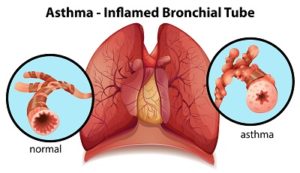What Is Asthma?
What Is Asthma?

Asthma is a long-term chronic disease involving the airways (i.e., bronchial tubes) inside the lungs. In asthma, the bronchial tubes, which carry air in and out of lungs, are chronically inflamed.
Inflammation results in:
- Swelling and thickening of the walls of the bronchial tubes leading to a narrowing of the lumen (i.e., inside space of the bronchial tube).
- Spasm of the circular muscle in the walls of the bronchial tubes, adding to the narrowing of the lumen.
- Excessive mucus secretion by the lining inside the bronchial tubes resulting in the formation of “mucus plugs” which cause blockage of the lumen.
The above factors limit the amount of air reaching the part of the lungs where gas exchange normally takes place. Thus, asthma is primarily a reversible “obstructive” lung disease resulting in a reduced oxygen supply to various tissues and organs. Note that COPD (i.e., chronic obstructive pulmonary disease) is also an obstructive lung disease, but irreversible. The two types of COPD are emphysema and chronic bronchitis.
This process leads to the classic symptoms of asthma which may include:
- Wheezing – A high-pitched whistling noise caused by forcing air through narrow bronchial tubes.
- Cough – A natural reflex attempting to expel (i.e., expectorate) excessive secretions from the lungs.
- Chest tightness and shortness of breath – Caused by bronchospasm and inadequate air movement through the lungs.
- Rapid and shallow breaths – An effort to compensate for the reduced amount of air entry into lungs in each individual breath.
- Sleep disturbances and lower energy levels – Due to reduced oxygenation over time.
One in 12 people in U.S. (i.e., about 25 million, or 8% of the U.S. population) are estimated to have asthma and more than half of them experience an acute flare-up yearly.












